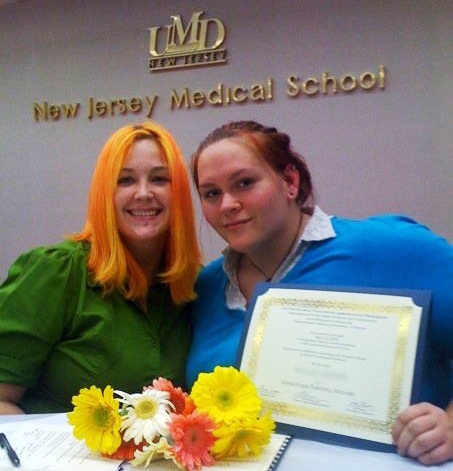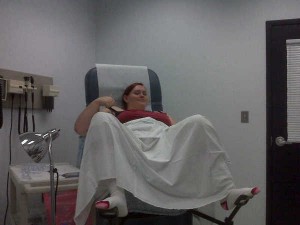
Many women dread getting a pelvic exam from their gynecologists just once a year. Ammre Ulrich has gotten 13 in one day.
A medical marvel? Excruciating torture? Nope, just another day at work as a GTA.
I had never even heard of GTAs before Ammre became one. In fact, the first words that came to mind when hearing the abbreviation “GTA” were “Grand Theft Auto”, because my little brother has a Playstation 2.
But as far as my friend Ammre is concerned, GTA stands for “Gynecological Teaching Associate”, not a felony.
GTAs are trained women that are employed to teach medical students how to properly perform a gynecological exam. They instruct the students so that they know “what they are feeling, and how to feel it,” Ammre says.
They also give feedback so that the students know if they are causing unnecessary pain, or if they did anything to make the patient uncomfortable.
Ammre decided to become a GTA after attending a conference in Amherst, Massachusetts called “From Abortion Rights to Social Justice”, put on by the Civil Liberties and Public Policy program at Hampshire College.
“One of the seminars I went to was called, ‘Demystifying Women’s Reproductive Health’,” says Ammre. “It taught how a GYN exam should be, what you should expect, and what you can do to empower yourself so that you aren’t a third party in your own reproductive health.”
Ammre says when she first heard about the job, “My first thought was, ‘Sweet, an alternative job that uses my body in a way to subvert the standard notions of propriety.'” Eventually, as she learned more about Gynecological Teaching Associates, she says she “came to love the fact that it was also a job that would help shape the future of women’s healthcare for the better.”
To become a GTA, Ammre went through between 10 and 20 hours of paid training. This entailed first observing a teaching session to see how they are run. “You get a feeling for how the room is run and how invasive it can be,” she says. “At that point, you will probably either fall in love with the idea, or run in fear – either are acceptable responses.”
Then, GTAs-in-training are taught to perform breast and pelvic exams as if they were medical students themselves. Through this, they become accustomed to the nervousness that can accompany performing such exams, as well as experience various methods of teaching the same material.
“Everyone in my program has had the, ‘Oh god, I’m about to put a speculum in someone’ moment,” Ammre says. “We know what the students will go through.”
Those in training are then put in a room with an experienced GTA, and help teach part of a session, being corrected as needed. This is called “team teaching”, and GTAs-in-training get up to three of these sessions. Ammre says that the team teaching helps because, “You get to see how your future coworkers run their sessions, and you pick up other ways of phrasing things so that the students understand.”
Once this aspect of training is completed, the new GTAs get their own rooms so that they may teach sessions by themselves.
A typical day at work for Ammre involves arriving and setting up the room. GTAs get out the things they will need, like speculums, lube, mirrors, pillows, drapes and gowns, and sometimes rearrange the furniture to make teaching the session easier.
Am I forgetting anything? Oh, right. “Pee… That’s important right before a session,” Ammre says.

Then, medical students arrive and receive a brief introduction telling them about the program and the training the GTAs have received from their director. Anywhere from two to five students are then assigned to a room that Ammre is teaching in. Ammre lets the students know the protocol of the exam, and then the students practice all of the techniques – on her. When all of the students are done, Ammre sets up the room again and the process starts over and repeats until she is done working that day.
Surprisingly, Ammre says there is no significant toll on her body. “Some days when I’ve had a lot of students, I’ll just want to put on super comfy granny panties and sweat pants and curl up with my computer or a book. But with just a few students, I barely notice it.”
Ammre is paid well as a GTA, but her only real complaint about the job is that the work is not steady enough. GTAs’ busy seasons are around the time new semesters at school start, but otherwise they are not consistently employed. “Some months I can pay bills, and some I have to wait,” she says.
Ammre supplements her income doing stagehand work. She graduated with a degree in graphic design (and is very talented, in this Cephaloblogger’s opinion), but has not taken a full-time position in her field, because it would make her unable to teach.
The reason she forgoes job security to be a GTA?Â
“I love it when you can tell that the student has actually taken something valuable away from the session. After they see us, they go straight to hospitals where they perform exams on normal women with only a warning of ‘This is a teaching hospital’,” she says. “I like thinking that they won’t be terrified, and they won’t hurt people because of something I’ve taught them.”
The other reason?
“I love seeing people’s reactions at first when I tell them what I do!”
Â
If you’d like to learn more about Gynecological Teaching Associates, please check out this amazing documentary called At Your Cervix (trailer is below) or this great (albeit old) article from the San Francisco Chronicle.
Â
I know her!
Good article. 🙂
A most excellent article 🙂